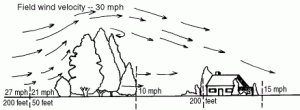Windbreaks refer to a linear planting of trees or shrubs that are placed in such a way that they are designed to provide shelter from the wind and protect soil from erosion. They are mostly used in farms or fields in order to protect crops and livestock. However, when placed correctly, the same idea can be used around a home in order to reduce heating and cooling costs and save energy. They can also be used in some regions to keep snow from drifting into roadways. Fun fact: the term for a jacket, “windbreaker” actually gets it’s name from this landscape design!
The best windbreaks block wind close to the ground by using low-growing trees and shrubs. Trees, bushes, and shrubs are often planted together to block or impede wind. Dense evergreen trees and shrubs planted to the north and northwest of the home are the most common type of windbreak. Evergreen trees can deflect or lift the wind over the home, but be careful not to plant evergreens too close to the south side of your home if you are counting on receiving warmth from the sun.
Windbreaks began being used in the 19th century, on a limited scale. Some of the early forest rows, such as “Genko’s Forest Belt” in Russia, have now been officially declared nature reserves. Forest projects, including large-scale planting of windbreaks, have been proposed by the government more than once as a way to reduce soil erosion and improve microclimate in otherwise treeless areas. To learn more from John Madison Landscape, or to receive a free estimate on your landscape design, click here or call us at 407-935-9151.



0 Comments